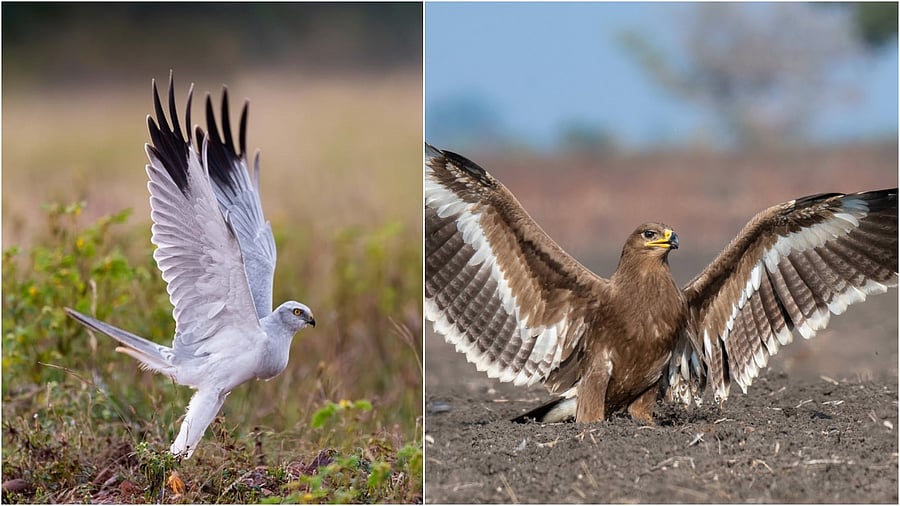
Pallid Harrier(L), Steppe eagle
Credit: Special Arrangement
Hubbali: This year winter migration of birds to Karnataka started with a bang as the birders recorded the arrival of two rare species: Sykes's Nightjar (found in northwestern South Asia) and Himalayan Rubythroat (found in Himalayas).
However, experts state that over the years the diverse landscape of Karnataka, which is part of the central Asian flyway, is witnessing a decline in the number of species visiting their winter homes and stop-over spots. The state used to be host for several migratory birds of Eurasian and central Central Asian.
Moreover, there is no consolidated scientifically backed data record in the State regarding the total number of bird species in State. Based on the citizen scientists sightings the eBird, an online database of bird observations, has recorded the presence of nearly 555 species resident, local migrants and migratory birds in the State.
Winter migration in the state usually commences from the first week of October and lasts till early March. However, as the state has not recorded all the habitats in State, there is no consolidated data of the migratory birds visiting the State.
Climate change, changes in land-use pattern, modification in cropping pattern, disturbance at habitats, threats, availability of food and impact of transit route has adversely impacted the migratory pattern of birds, which are considered as indicator species. “Any slightest change in habitat and condition would deter birds from making that habitat as their winter home,” says Bombay Natural History Society (BNHS) State Coordinator Karthik NJ, who is conducting study on river-terns and other birds in Bhadra Tiger reserve and north Karnataka.
The State of India’s Bird 2023 (SoIB 2023) report states that in the last two decades, several migratory species' arrival to water bodies, grasslands, forests and coastal areas has decreased by nearly 50% to 60%. Ashwin Viswanathan, a part of the SoIB team, says: “Birds that have vertebrate or invertebrate diets have declined most rapidly. Among habitats, grasslands are the most threatened with grassland species such as harriers (Montagu's Harrier, Pallid Harrier, and Western Marsh Harrier), Indian roller (State bird of Karnataka) and Indian Courser rapidly declining because of many reasons, including grassland habitat loss and conversion to plantations. Other raptors like Tawny Eagle, Black-winged Kite and Eurasian Kestrel which prefer open habitats are also witnessing a sharp decline.”
He says reporting of harriers and coursers has declined in Karnataka and coursers seem to have completely disappeared from some sites.
Lack of data is one of the major reasons for the State’s failure to protect the birds' habitat and population. Though Karnataka was among the first states to come up with bird counts and bird festivals in the country, however, today it lacks a consolidated effort in protecting its avian diversity. Experts give the example of Uttarakhand, Himachal Pradesh bird-race where the forest departments in coordination with local birders search each and every possible habitat over three days to prepare a centralized data-base.
Senior birder S Subramanya says that bird recording is a complex issue. “Given the excess rainfall we received this year, the majority of the water bodies are full. The birds might have dispersed far and wide to a different place avoiding their usual hot-spots. This does not mean that the birds have not arrived, and one needs to visit a large number and variety of habitats.”
He says that there is a need for the State government to identify important bird areas and bring more of these areas under state protection by declaring them as sanctuaries, Ramsar Sites and Conservation Reserves. He said that with the city lakes being developed into soup-bowl shaped structures and filled with polluted waters, the century old structure and ecology of these water bodies that once used to be bird-friendly has changed. Under this scenario, there is a need to bring large tracts of the backwaters of large reservoirs which support huge numbers of both resident and migratory water birds, under State protection.
Karthik says Karnataka is making very little efforts in identifying and protecting avian habitats in coastal areas, where waders, marine species of birds arrive. “Along with protecting northern plains, we also need to concentrate on the west coast, estuaries, and salt banks,” he says.
He says the State’s concentration should not just be its Ramsar Sites, water bodies, and protected areas but also the bird corridors, their stop-over places and roosting sites. “We need to conserve the entire bird-ecology,” he says.
Principal Chief Conservator of Forests (Wildlife) P C Ray says bird survey is very important and the department will soon take up this. “Every protected area is conducting bird surveys and fest. We also need consolidated data on birds,” he says.